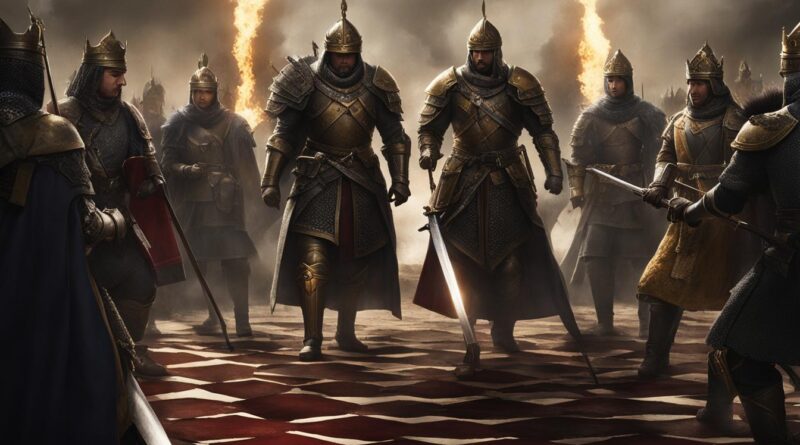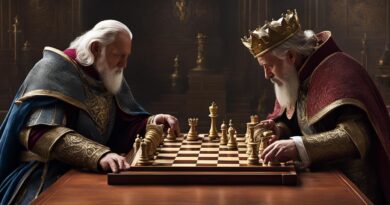Queen and Pawns vs. King and Rook in Chess
In the game of chess, certain endgame scenarios involve the queen and pawns against a king and rook. These types of positions require strategic thinking and careful maneuvering to achieve victory. Understanding the key concepts, checkmate patterns, and utilizing chess tablebases can greatly enhance a player’s chances of success.
Key Takeaways:
- Chess strategy is crucial in queen and pawns vs. king and rook endgames.
- Study the checkmate patterns and familiarize yourself with the common tactics used in these scenarios.
- Chess tablebases can provide valuable insights and analysis on optimal moves.
- Strategic piece coordination and understanding the importance of king placement are essential in achieving victory.
- Mastering queen and pawns vs. king and rook endgames requires practice, analysis, and a deep understanding of the game.
The Basics of Pawnless Endgames
Pawnless endgames occur when only a few pieces remain on the chessboard without any pawns. These endgames come with their own unique dynamics and strategic considerations. Understanding the fundamental concepts and checkmate patterns in pawnless endgames is crucial for any chess player looking to improve their endgame skills.
In pawnless endgames, some of the basic types include king and queen vs. king, king and rook vs. king, and queen vs. rook. These positions have been studied for centuries, with players analyzing different plans, strategies, and winning ideas. Recent advancements in endgame tablebases have further deepened our understanding of these complex positions, providing accurate evaluations and optimal moves in various pawnless endgame scenarios.
To illustrate the importance of studying pawnless endgames, consider the following example:
| Pawnless Endgame Type | Key Concepts | Strategy |
|---|---|---|
| King and Queen vs. King | Utilize the queen’s mobility and coordinate with the king to create checkmate threats. | Focus on restricting the opponent’s king and creating mating patterns. |
| King and Rook vs. King | Activate the rook by targeting weak pawns and supporting the advance of your own pawns. | Utilize the king as a strong attacking piece and aim to create mating threats. |
| Queen vs. Rook | Exploit the queen’s superior mobility to attack the rook and win material. | Create tactical opportunities such as forks and mating threats to secure an advantage. |
By understanding the basics of pawnless endgames and studying the various endgame tablebases available, chess players can develop a deeper appreciation for the strategic nuances of these positions and improve their chances of success.
Table: Key Concepts and Strategies in Pawnless Endgames
Queen vs. Rook in the Endgame
When it comes to the endgame scenario of a queen facing off against a lone rook, the queen typically has the advantage. However, this doesn’t mean that victory is guaranteed. The defending side can employ certain defensive strategies, such as the third-rank defense, making it challenging for the queen to achieve a win.
In this endgame, one common winning strategy involves maneuvering the queen to win the rook with a fork. By placing the queen in a position where it simultaneously attacks both the rook and another valuable piece, such as the king, the defending side is forced to make difficult choices.
Third-Rank Defense
The third-rank defense is a defensive strategy commonly used by the side with the rook. The rook is placed on the third rank, horizontally opposite the attacking queen. This defense aims to restrict the queen’s scope and limit its attacking options. By controlling key squares and challenging the queen’s movements, the defending side increases its chances of holding off the queen and securing a draw.
The Philidor position is another important concept to understand in this endgame scenario. Named after the French chess player François-André Danican Philidor, this position involves the defending king being placed on the eighth rank, protected by the rook. This setup creates a solid defensive fortress, making it difficult for the queen to make progress and achieve a win.
In summary, while the queen generally holds the advantage in a queen vs. rook endgame, the defensive strategies of the defending side, such as the third-rank defense and the Philidor position, can make it challenging for the queen to secure a victory. Players must carefully consider their moves and use strategic thinking to maximize their chances of success in this intricate endgame scenario.
Third-Rank Defense
| Third-Rank Defense | Advantages | Disadvantages |
|---|---|---|
| Restricts queen’s scope | Increases chances of holding off the queen | Requires precise coordination and positioning |
| Challenges queen’s movements | Creates a solid defensive fortress | May limit the rook’s activity |
Queen vs. Two Minor Pieces
A queen against two minor pieces, such as a bishop and a knight, presents interesting challenges for both players in pawnless endgames. The defending side can create defensive fortresses to hold off the queen’s attacks and secure a draw. However, the queen still has theoretical winning chances against two bishops, while a draw is more likely in the case of two knights. Understanding the dynamics of these pawnless endings is crucial for making informed decisions.
Common Pawnless Endings
| Endgame Type | Characteristics |
|---|---|
| Queen vs. Bishop and Knight | The queen has winning chances against two bishops, especially if they are on different-colored squares. A draw is more likely when facing two knights. |
| Bishop and Knight vs. Queen | The defending side can create defensive fortresses using the bishop and knight to hold off the queen’s attacks and secure a draw. |
Defensive Fortresses: Holding off the Queen
In queen vs. two minor pieces endgames, the defending side aims to establish defensive fortresses that prevent the queen from making significant progress. A fortress involves placing the minor pieces in strategic positions to create a solid defensive structure.
One common defensive strategy is to position the bishop and knight in a way that restricts the queen’s mobility and blocks potential checkmate threats. By controlling key squares and restraining the queen’s attacks, the defending side can make it incredibly difficult for the queen to break through and achieve a decisive advantage. However, achieving a fortress can be challenging and requires precise coordination.
On the other hand, the side with the queen must look for opportunities to disrupt the fortress and create weaknesses in the defense. By exploiting tactical possibilities and creating threats that the defending side must respond to, the queen player can increase their chances of success. Careful calculation, piece coordination, and strategic maneuvering play crucial roles in determining the outcome of these fascinating pawnless endgames.
Table: Queen vs. Two Minor Pieces
| Queen vs. Bishop and Knight | Queen vs. Two Knights |
|---|---|
| The queen has theoretical winning chances, especially if the bishops are on different-colored squares. | A draw is the most likely result in this scenario. |
| The presence of a queen offers more tactical possibilities and winning opportunities. | The defending side can create strong defensive fortresses with the two knights. |
Rook vs. Bishop and Rook Endgame
In the rook vs. bishop and rook endgame, players are faced with intricate defensive methods and tactical strategies. This pawnless endgame scenario offers both sides opportunities to secure victory, but it requires careful calculation and understanding of key defensive techniques.
The Cochrane Defense is one such method that can be employed by the defending side. It involves sacrificing the rook to create counterplay and disrupt the attacking rook’s coordination with the bishop. This defensive resource can lead to dynamic imbalances and increase the chances of holding a draw or even securing a win.
Another defensive method commonly used in this endgame is the second rank defense. The defending rook aligns itself on the second rank, effectively preventing the attacking rook from infiltrating the position. By guarding crucial squares and restricting the opponent’s rook, the defending side can protect against checkmate threats and maintain a solid defensive stance.
Table: Key Defensive Methods in Rook vs. Bishop and Rook Endgame
| Defensive Method | Description |
|---|---|
| Cochrane Defense | Sacrificing the rook to disrupt the coordination between the attacking rook and the bishop |
| Second Rank Defense | Positioning the defending rook on the second rank to block the opponent’s rook and protect essential squares |
By employing these defensive methods and considering the unique dynamics of the rook vs. bishop and rook endgame, players can navigate the complexities of this pawnless endgame scenario and increase their chances of reaching a favorable outcome.
Queen and Pawn vs. Queen Endgame
The queen and pawn versus queen endgame is a highly intricate and challenging scenario in chess. It requires precise calculation, strategic thinking, and an understanding of winning strategies. One key tactic often used in this endgame is the concept of cross-checks. Cross-checks involve simultaneously checking the opponent’s king while uncovering an attack with the queen. By forcing the exchange of queens, cross-checks can create winning opportunities.
Another important aspect to consider in the queen and pawn versus queen endgame is the placement of the defending king. The defending king plays a crucial role in defending against the opponent’s queen and must be carefully positioned to avoid potential threats and create defensive fortifications. Optimal king placement can significantly increase the chances of holding off the opponent’s attacks and securing a draw.
Winning Strategies
Several winning strategies can be employed in the queen and pawn versus queen endgame. The importance of centralizing the queen and coordinating it with the pawn cannot be overstated. By controlling key squares and creating threats, the attacking side can put pressure on the defending queen and king. Additionally, accurate calculation and foresight are vital to anticipate the opponent’s moves and identify winning motifs.
It is also crucial to be mindful of potential stalemate traps. Stalemate occurs when the defending king is not in check but has no legal moves. In the queen and pawn versus queen endgame, stalemate can unexpectedly result in a draw instead of a win for the attacking side. Therefore, players must constantly evaluate the position and ensure that their moves are not inadvertently leading to a stalemate.
| Winning Strategies in Queen and Pawn vs. Queen Endgame | Points to Consider |
|---|---|
| Utilize cross-checks | Simultaneously check the opponent’s king while uncovering an attack with the queen |
| Optimal king placement | Position the defending king to defend against threats and create defensive fortifications |
| Centralize the queen | Control key squares, create threats, and put pressure on the defending queen and king |
| Beware of stalemate traps | Ensure moves do not inadvertently lead to a stalemate, which would result in a draw |
Winning Strategies for Different Pawns
In queen and pawn vs. king and rook endgames, the type of pawn involved plays a crucial role in determining the winning chances. Let’s take a closer look at the characteristics of each pawn type and the strategies that can be employed to maximize the chances of victory.
Rook Pawn:
The rook pawn, located on either the a-file or h-file, offers the greatest opportunities for success in endgames. Due to its position on the edge of the board, it can often promote to a queen without being stopped by the defending rook. Utilizing the rook pawn’s potential and creating favorable pawn structures is key to securing a win.
Knight Pawn:
The knight pawn, positioned on the b-file or g-file, is relatively easier to win compared to other pawns. Its ability to control central squares and limit the opposing king’s mobility gives it an advantage. Active king maneuvering, pawn breakthroughs, and the creation of mating threats are effective strategies in knight pawn endgames.
Bishop Pawn:
The bishop pawn, found on the c-file or f-file, offers the best winning chances. Its position in the center of the board allows for greater control and flexibility. Creating pawn breaks, activating the king, and exploiting weak points in the opponent’s position are essential tactics in bishop pawn endgames.
Central Pawn:
The central pawn, occupying the d-file or e-file, falls somewhere in between the other pawn types in terms of winning chances. Its location grants it influence over both flanks of the board. Strategic pawn advances, piece coordination, and accurate calculation are crucial in maximizing the winning potential of central pawn endgames.
Understanding the unique characteristics and strategic nuances associated with each pawn type is vital for formulating winning strategies in queen and pawn vs. king and rook endgames. By recognizing the strengths and weaknesses of different pawn structures, players can make informed decisions and increase their chances of success.
Historical Analysis of Queen vs. Rook Endgames
Queen vs. rook endgames have been subject to extensive historical analysis, providing valuable insights into the complexities of this endgame scenario. One notable game that stands out is the match between Mikhail Botvinnik and Igor Ravinsky in 1943. This game showcased the strategic maneuvering and tactical brilliance required to navigate the intricate balance between the queen and rook.
Throughout history, renowned chess players like François-André Danican Philidor have made significant contributions to our understanding of queen vs. rook endgames. Philidor’s studies emphasized the importance of king activity and accurate piece coordination, shedding light on various winning strategies and drawing fortress concepts.
With the advent of endgame tablebases, the analysis of queen vs. rook endgames has reached new heights. Endgame tablebases provide precise and comprehensive analysis of various positions, uncovering winning strategies that were previously unknown. This modern tool has revolutionized our understanding of the queen vs. rook endgame, enabling players to explore the depths of this highly complex scenario.
| Historical Analysis | Game | Contributors |
|---|---|---|
| Botvinnik vs. Ravinsky (1943) | Intense strategic and tactical battle | Mikhail Botvinnik, Igor Ravinsky |
| Philidor’s Studies | Revolutionary insights into queen vs. rook endgames | François-André Danican Philidor |
| Endgame Tablebases | Precise analysis and uncovering winning strategies | Modern chess engines |
The combination of historical analysis, innovative studies, and the power of endgame tablebases allow players to delve into the intricate world of queen vs. rook endgames. By exploring these resources and studying the games of masters’ past, players can gain a deeper understanding of the complexities involved in this challenging endgame scenario.
Challenges of Queen vs. Rook and Pawn Endgames
Queen vs. rook and pawn endgames present a unique set of challenges due to the presence of an additional pawn. The defending side has the opportunity to create drawing fortresses and secure a draw, while the side with the queen must utilize winning strategies to break through the defenses and achieve victory.
One of the main challenges for the side with the queen is overcoming the drawing fortresses created by the defending rook and pawn. These fortresses are defensive setups that make it difficult for the queen to penetrate and create winning chances. The defending side strategically places their rook and pawn to create a solid defensive structure.
Table: Typical Drawing Fortresses in Queen vs. Rook and Pawn Endgames
| Fortress Configuration | Description |
|---|---|
| King and rook on the third rank | The rook is placed on the third rank to protect the pawn, while the king supports the defense. |
| King and rook on the second rank | The rook is placed on the second rank to shield the pawn, while the king assists in maintaining the fortress. |
To overcome these drawing fortresses, the side with the queen must employ winning strategies that aim to destabilize the defensive setup. This can be achieved through tactical maneuvers, forcing the rook to abandon its defensive position or creating distractions to divert the defending side’s attention.
Additionally, careful calculation and an understanding of winning motifs are crucial in these intricate endgame scenarios. Recognizing the key positional and tactical elements that can lead to breakthroughs is essential. These include exploiting weaknesses in the fortress, creating mating threats, or utilizing the pawn as a decoy to distract the defending rook.
By navigating these challenges and applying effective winning strategies, the side with the queen in queen vs. rook and pawn endgames can overcome drawing fortresses and secure victory.
The Importance of Endgame Tablebases in Queen vs. Rook Endgames
The use of endgame tablebases has revolutionized the analysis of queen vs. rook endgames. These powerful databases provide precise analysis of various positions, allowing players to uncover winning strategies that were previously unknown. Endgame tablebases offer comprehensive information on the best moves and winning positions, greatly enhancing our understanding of this complex endgame scenario.
With endgame tablebases, players can confidently navigate through the intricacies of queen vs. rook endgames. These databases provide accurate evaluations of different moves and help players identify winning paths to victory. By consulting endgame tablebases, players can confidently make informed decisions based on precise analysis and deep insights into winning positions.
Benefits of Endgame Tablebases
Endgame tablebases offer numerous benefits in studying queen vs. rook endgames:
| 1. Precise Analysis | 2. Winning Positions | 3. Accurate Evaluations |
|---|---|---|
| Endgame tablebases provide precise analysis of various positions, helping players make optimal moves. | By consulting endgame tablebases, players can discover winning positions and develop winning strategies. | Endgame tablebases offer accurate evaluations of different moves, guiding players towards winning paths. |
Players of all skill levels can benefit from using endgame tablebases to study queen vs. rook endgames. Whether it’s understanding the complexity of pawnless endgames or discovering new winning strategies, endgame tablebases provide an invaluable resource for chess players seeking to improve their skills and achieve success in this ultimate chess challenge.
Tips for Mastering Queen and Pawns vs. King and Rook Endgames
Mastering queen and pawns vs. king and rook endgames requires a combination of strategic thinking, effective piece coordination, and optimal king placement. These complex endgame scenarios demand careful planning and precise execution. Here are some valuable tips to enhance your skills and increase your chances of success:
1. Strategic Thinking
Developing a strategic mindset is crucial in queen and pawns vs. king and rook endgames. Plan your moves in advance, considering long-term objectives and potential threats. Identify weaknesses in your opponent’s position and exploit them strategically. Evaluate the value of each move and assess its consequences to make informed decisions that align with your overall game plan.
2. Piece Coordination
Effective coordination between your queen and pawns is vital to create threats and control key squares. Utilize your queen’s mobility to attack the opponent’s king and restrict the rook’s movements. Coordinate your pawns to create pawn chains and support your queen’s advancements. Avoid leaving any weak pawns that can be targeted by the opponent’s rook. Efficient piece coordination will give you a significant advantage in these endgames.
3. Optimal King Placement
The placement of your king plays a crucial role in determining the outcome of the endgame. Keep your king safe from checks and potential mating threats. Seek opportunities to improve your king’s position by moving it closer to the center of the board and away from the opponent’s threats. A well-placed king can provide defensive support and help create counterplay opportunities.
By integrating these tips into your gameplay, you can enhance your endgame skills and increase your chances of success in queen and pawns vs. king and rook endgames. Remember to practice regularly, analyze historical games, and study endgame tablebases to deepen your understanding of these complex positions.
Conclusion: Queen and Pawns vs. King and Rook – The Ultimate Chess Challenge
Mastering the queen and pawns vs. king and rook endgame is the ultimate chess challenge, requiring a combination of endgame mastery and detailed strategies. These complex positions test a player’s deep understanding of the game, as well as their ability to analyze and strategize effectively.
By studying historical games and analyzing endgame tablebases, players can gain valuable insights into the intricacies of these endgame scenarios. These resources provide a wealth of knowledge, enabling players to uncover winning strategies that were previously unknown.
Implementing detailed strategies is crucial in these endgames. Strategic thinking, piece coordination, and optimal king placement are key factors that can determine the outcome of the game. It is also important to anticipate potential threats and calculate long-term plans to ensure success in these challenging positions.
With dedication and practice, players can improve their skills in queen and pawns vs. king and rook endgames. The journey towards mastering these complex positions may be demanding, but the rewards of endgame mastery and the thrill of overcoming the ultimate chess challenge are well worth the effort.
FAQ
Are pawnless endgames common in chess?
Yes, pawnless endgames, where only a few pieces remain without any pawns, are common in chess and have their own unique dynamics.
What are the basic checkmates in pawnless endgames?
The basic checkmates in pawnless endgames include king and queen vs. king, king and rook vs. king, and queen vs. rook.
How can the queen win against a lone rook in the endgame?
The queen generally has the advantage, and one common winning strategy involves maneuvering the queen to win the rook with a fork. Another important concept is the Philidor position.
What are the challenges in a queen vs. two minor pieces endgame?
The defending side can create defensive fortresses, but the queen has theoretical winning chances against two bishops, while a draw is more likely in the case of two knights.
How can the rook and bishop defend against a queen in the endgame?
Different defensive methods, such as the Cochrane Defense and the second rank defense, can be employed to hold off the rook’s attacks.
How can the queen achieve victory against a king and pawn?
The queen and pawn versus queen endgame is highly complex and requires precise calculation and strategic thinking. Cross-checks are often used to force the exchange of queens and create winning opportunities.
Which types of pawns offer the best winning chances in endgames?
The rook pawn offers the most opportunities for victory, while the knight pawn is relatively easier to win compared to other pawns. The bishop pawn provides the best winning chances, and the central pawn falls somewhere in between.
What historical games have contributed to the understanding of queen vs. rook endgames?
Games such as the one between Botvinnik and Ravinsky have provided valuable insights into the complexities of this endgame. Notable chess players, including Philidor, have also made significant contributions to our understanding of queen and rook endgames.
How can the queen break through defenses in a queen vs. rook and pawn endgame?
Drawing fortresses can be created to defend against the queen’s attacks and secure a draw. However, the side with the queen can employ winning strategies to break through the defenses and secure victory.
How have endgame tablebases revolutionized analysis of queen vs. rook endgames?
Endgame tablebases provide precise analysis of various positions and help uncover winning strategies that were previously unknown. They have greatly enhanced our understanding of this complex endgame scenario.
What tips can help in mastering queen and pawns vs. king and rook endgames?
Focus on strategic thinking and piece coordination. Optimally placing the defending king and creating defensive fortresses can significantly improve the chances of holding off the queen’s attacks.



